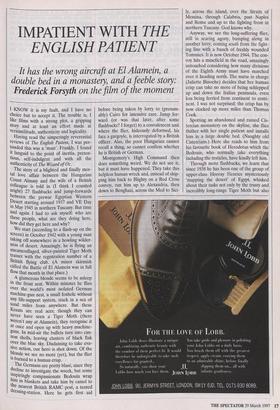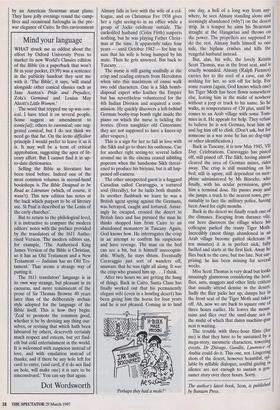IMPATIENT WITH THE ENGLISH PATIENT
It has the wrong aircraft at El Alamein, a
double bed in a monastay, and a feeble story:
Frederick Forsyth on the film of the moment I KNOW it is my fault, and I have no choice but to accept it. The trouble is, I like films with a strong plot, a gripping story and at least an effort made at verisimilitude, authenticity and logicality.
Having read the simperingly reverential reviews of The English Patient, I was per- suaded this was a 'must'. Frankly, I found it languid to the point of inertia, preten- tious, self-indulgent and with all the authenticity of The Wizard of Oz. The story of a blighted and finally mor- tal love affair between the Hungarian Count Almasy and the wife of a British colleague is told in (I think I counted aright) 27 flashbacks and jump-forwards between the prewar Egyptian Western Desert starting around 1937 and YE Day in May 1945 in northern Tuscany. But time and again I had to ask myself: who are these people, what are they doing here, how did they get here and why? The story of a blighted and finally mor- tal love affair between the Hungarian Count Almasy and the wife of a British colleague is told in (I think I counted aright) 27 flashbacks and jump-forwards between the prewar Egyptian Western Desert starting around 1937 and YE Day in May 1945 in northern Tuscany. But time and again I had to ask myself: who are these people, what are they doing here, how did they get here and why? We start (according to a flash-up on the screen) in October 1942 with a young man taking off somewhere in a howling wilder- ness of desert. Amazingly, he is flying an uncamouflaged, silver-painted Tiger Moth trainer with the registration number of a British flying club. (A minor skirmish called the Battle of El Alamein was in full flow that month in that place.) A glamorous blonde seems to be asleep in the front seat. Within minutes he flies over the world's most isolated German machine-gun nest, a small foxhole without any life-support system, stuck in a sea of sand miles from anywhere. But these Krauts are real aces; though they can never have seen a Tiger Moth (there weren't any at Alamein), they recognise it at once and open up with heavy machine- guns. In mid-air the bullets turn into can- non shells, leaving clusters of black flak over the blue sky. Disdaining to take eva- sive action, our hero is shot down. Of the blonde we see no more (yet), but the flier is burned to a human crisp. The Germans are pretty blasé, since they decline to investigate the wreck, but some inspiringly compassionate Bedouin wrap him in blankets and take him by camel to the nearest British RAMC post, a tented clressit,„ g. station. Here he gets first aid before being taken by lorry to (presum- ably) Cairo for intensive care. Jump for- ward (or was that later, after some flashbacks? I forget) to a convalescent unit where the flier, hideously deformed, his face a gargoyle, is interrogated by a British officer. Alas, the poor Hungarian cannot recall a thing, so cannot confirm whether he is British or German.
Montgomery's High Command then does something weird. We do not see it, but it must have happened. They take this helpless human wreck and, instead of ship- ping him back to Blighty on a Red Cross convoy, ran him up to Alexandria, then down to Benghazi, across the Med to Sici- ly, across the island, over the Straits of Messina, through Calabria, past Naples and Rome and up to the fighting front in northern Tuscany. God knows why.
Anyway, we see the long-suffering flier, still in searing agony, bumping along in another lorry, coming south from the fight- ing line with a bunch of freshly wounded Tommies. It is now October 1944. The con- voy hits a minefield in the road, amazingly untouched considering how many divisions of the Eighth Army must have marched over it heading north. The nurse in charge (Juliette Binoche) decides that her human crisp can take no more of being schlepped up and down the Italian peninsula, even less being ferried from continent to conti- nent. I was not surprised; the crisp has by now clocked up more miles than Thomas Cook.
Spotting an abandoned and ruined Cis- tercian monastery on the skyline, she flies thither with her single patient and installs him in a large double bed. (Naughty old Cistercians.) Here she reads to him from his favourite book of Herodotus which the Bedouin, who normally take everything including the testicles, have kindly left him.
Through more flashbacks, we learn that since 1938 he has been one of the group of upper-class Hooray Henries mysteriously 'mapping the desert' of Egypt, whisked about their tasks not only by the trusty and incredibly long-range Tiger Moth but also by an American &carman stunt plane. They have jolly evenings round the camp- fires and occasional furloughs in the pre- war elegance of Cairo. In this environment Almasy fails in love with the wife of a col- league, and on Christmas Eve 1938 gives her a right seeing-to in an office while a group of Jocks celebrate outside. The cuckolded husband (Colin Firth) suspects nothing, but he was playing Father Christ- mas at the time. It apparently takes four years — until October 1942 — for him to suss that his wife is being humped by his mate. Then he gets annoyed. But back to Tuscany.. .
The nurse is still gazing soulfully at the crisp and reading extracts from Herodotus when into this maelstrom of ennui walk two odd characters. One is a Sikh bomb- disposal expert who loathes the Empire but has nevertheless volunteered for the 4th Indian Division and acquired a com- mission. He quickly discovers a left-behind German booby-trap bomb right inside the piano on which the nurse is tickling the ivories. (Even naughtier old Cistercians; they are not supposed to have a knees-up after vespers.) This is a sign for her to fall in love with the Sikh and go to share his outhouse. Cue for another right seeing-to; several ladies around me in the cinema ceased nibbling popcorn when the handsome Sikh threat- ened to produce his biriyani, but it all hap- pened off-camera.
The other unexpected guest is a haggard Canadian called Caravaggio, a tortured soul (literally), for he lacks both thumbs. In another flashback we learn he was a British agent spying against the Germans, was betrayed, caught and tortured. Amaz- ingly he escaped, crossed the desert to British lines and has pursued the man he thinks shopped him from Cairo to an abandoned monastery in Tuscany. Again, God knows how. He interrogates the crisp in an attempt to confirm his suspicions and have revenge. The man on the bed can see a bit, but is himself unrecognis- able. Wisely, he stays shtum. Eventually Caravaggio just sort of wanders off, unaware that he was right all along. It was the crisp who grassed him up. . . I think.
After two hours we are getting the hang of things. Back in Cairo, Santa Claus has finally worked out that his permanently elegant wife (even in a howling desert) has been giving him the horns for four years and he is not pleased. Coming in to land 'Perhaps they had a mole?' one day, a hell of a long way from any- where, he sees Almasy standing alone and seemingly abandoned (why?) on the desert strip. In a temper he aims his Stearman straight at the Hungarian and throws on the power. The propellers are supposed to do the rest. Almasy hurls himself to one side, the biplane crashes and kills the vengeful husband instead.
But, alas, his wife, the lovely Kristin Scott Thomas, was in the front seat, and is cruelly wounded. Almasy (Ralph Fiennes) carries her to the cool of a cave, can do nothing for her, so sets off for help. For some reason (again, God knows which one) his Tiger Moth has been flown somewhere else, leaving him in the midst of nowhere without a jeep or truck to his name. So he walks, in temperatures of 120 plus, until he comes to an Arab village with some Tom- mies in it. He appeals for help. They refuse to believe he is not German, beat him up and lug him off to clink, (Don't ask, but for someone in a war zone he has no dog-tags or other identification.) Back in Tuscany, it is now May 1945, VE Day. Celebrations. Caravaggio has pissed off, still pissed off. The Sikh, having almost cleared the area of German mines, rides away. The crisp is still mumbling on his bed, still in agony, still dependent on mor- phine administered by Ms Binoche, who finally, with his ocular permission, gives him a terminal dose. He passes away and she jumps a truck to the nearest town, pre- sumably to face the military police, having been Awol for eight months. Back in the desert we finally reach one of the climaxes. Escaping from durance vile, our hero discovers the village where his colleague parked the trusty Tiger Moth. Incredibly (most things abandoned in an Arab village become gutted skeletons in ten minutes) it is in perfect nick, fully fuelled and starts at the first kick. Away he flies back to the cave, but too late. Not sur- prising; he has been missing for several weeks.
Miss Scott Thomas is very dead but looks amazingly glamorous considering the heat, flies, ants, maggots and other little critters that usually attend demise in the desert. Sadly the flier picks her up, dumps her in the front seat of the Tiger Moth and takes off. Ah, now we are back to square one of three hours earlier. He leaves the moun- tains and flies over the sand-dune sea in the midst of which that damn machine-gun nest is waiting. The trouble with three-hour films (for me) is that they have to be sustained by a mega-story, mesmeric characters, towering events. Dr Zhivago, Gandhi, Lawrence of Arabia could do it. This one, not. Lingering shots of the desert, however beautiful, syl- lable by syllable dialogue, soulful gazing In silence are not enough to sustain a gos- samer story over three hours. Sony.
The author's latest book, Icon, is published by Bantam Press.



































































 Previous page
Previous page